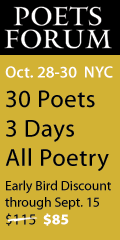 |
| GRACE CAVALIERI |
THE LITTLE e-NOTE: THE 1 QUESTION INTERVIEW
Grace Cavalieri, is founder/producer of public radio's "The Poet and the Poem," now from the Library of Congress, celebrating 33 years on the air. Her latest book is SOUNDS LIKE SOMETHING I WOULD SAY.
THE QUESTION:
You've interviewed many poets for the Library of Congress, which writers should we study for sound, rhythm or simply because of how they recite their words?
That is a difficult question although it looks straightforward enough. When we think of a poet reading, a large part of it is PERSONALITY that we can’t replicate. Think of Lucille Clifton - a reader above all others, but can we emulate that? The voice is so much a part of the poet’s spirit (voice= breath of God,) that to love a reading isn’t always a good reason to use that as a template to learn how to read. But it’s a fair question and an interesting one. Thomas Sayers Ellis uses his voice as a percussive instrument and this is effective because he makes it a cultural idiom. Should we all do that? Obviously not but he is one of the more interesting contemporaries—I think you (EE Miller) are inimitable because you manage intimacy in the phraseology which is in the poetry itself. The reader/listener takes it as personal, even in a public setting. Can we study this? No but we can be aware that content=delivery. Kay Ryan is worth taking a look at, because her tiny “pocket comb” shaped poems require precision in reading. There is so much compressed, each word is crystal cut and must be read that way. Herbert W. Martin reads in the style of old time Oratory and it’s a joy to hear history in his voice. Robert Pinsky uses his voice as an instrument beyond merely uttering his poems. He is keenly aware of the column of breath each of us calls our own. He claims a good poem on the page has the poet’s breath still on it and can be read as it was written. Dramatic readers like Kweli Smith and Holly Bass make the poem an event and we need to take a cue from that if we want luster and shine. Then think of the indigenous poets like Trinidadian Wilfred Cartey. What a reader. Robert Sargent , who had the sound of the Mississippi roiling in his voice. We can’t imitate it but we should note it. I guess the King of all readers is Sterling Brown and we can study him. Of course he invented his own cadence, but we can learn from it. Roland Flint should be remembered for his delivery… EVERY word pulled through the heart. I guess great readers are saying that if it doesn’t matter to the one reading, it can’t matter to the one listening. The poets I’ve mentioned had one thing in common: They did not apologize. So when we talk about rhythm, sound, etc. it all adds up to the nobility we give the word. W.S. Merwin reads as if he’s throwing words away to the wind and they can’t be owned, even by him; but it’s done from a very high place. I suppose the art of rhetoric does not apply to poets. Frederick Douglass counted syllables to emphasize his speech and punch the right meter. Poets are doing something else. But the question you ask is good because it makes us look at what is heard. We have to love our words as we say them. That’s good enough.







 In the latest installment of Writers Recommend, Glenn Taylor writes, "The blues is my antidote. The mind of a child is everything else."
In the latest installment of Writers Recommend, Glenn Taylor writes, "The blues is my antidote. The mind of a child is everything else." 


























